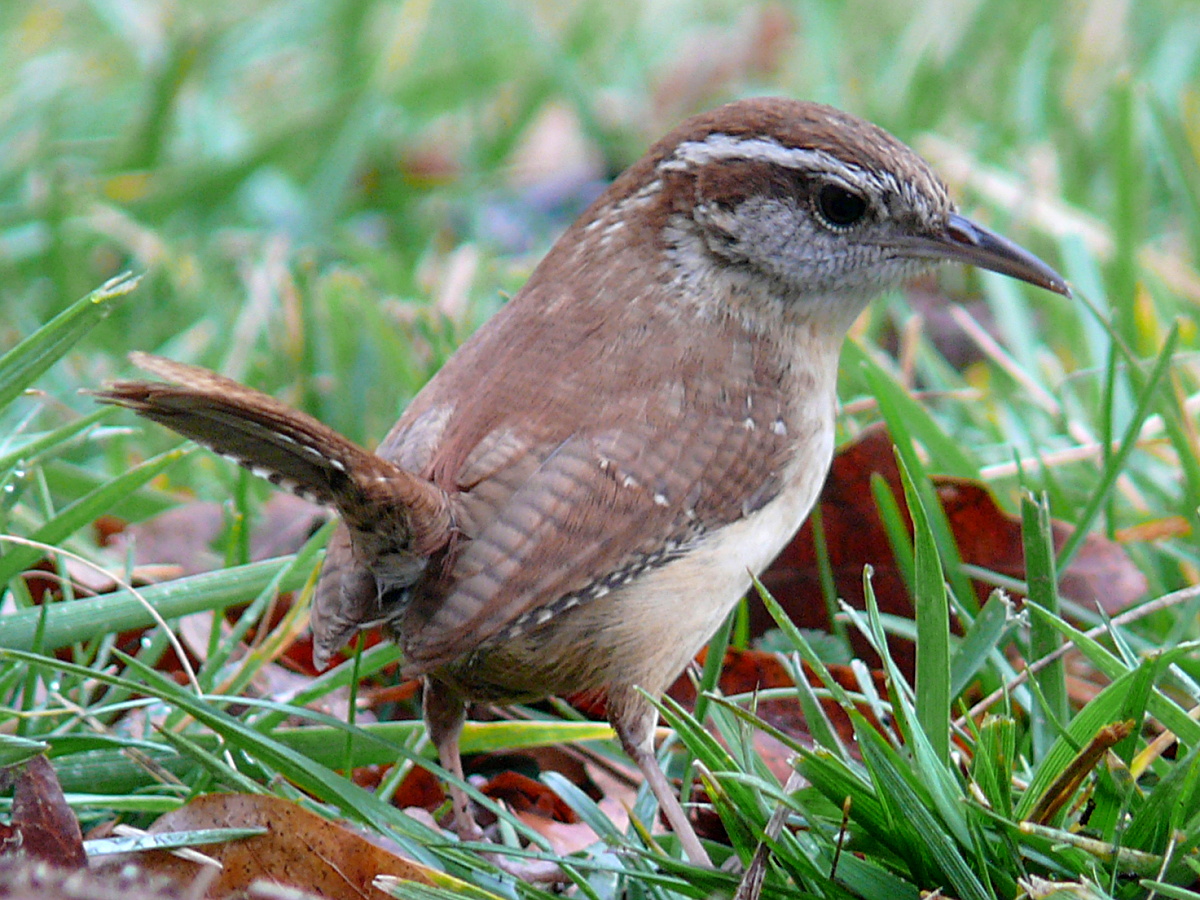- Carolina Wren
Taxobox
name = Carolina Wren

image_width = 260px
status = LC
status_system = iucn3.1
regnum =Animal ia
phylum =Chordata
classis = Aves
ordo =Passeriformes
familia =Troglodytidae
genus = "Thryothorus" (but see text)
genus_authority =
species = "T. ludovicianus"
binomial = "Thryothorus ludovicianus"
binomial_authority = (Latham,1790 )
range_
range_map_width = 260px
subdivision_ranks = Subspecies
subdivision = "T. l. burleighi" "T. l. lomitensis" "T. l. ludovicianus" "T. l. miamensis" "T. (l.) albinucha" - White-browed WrenThe Carolina Wren ("Thryothorus ludovicianus") is a common
species ofwren resident in the eastern half of theUSA , the extreme south ofOntario andQuebec ,Canada , and the extreme northeast ofMexico . A distinct population in theYucatan Peninsula of Mexico andBelize is treated either as asubspecies "Thryothorus ludovicianus albinucha", or as a separate species, White-browed Wren "Thryothorus albinucha". Following a 2006 review [Mann "et al." (2006)] , these are the only wrens remaining in thegenus "Thryothorus". "T. ludovicianus" is thestate bird ofSouth Carolina ; itsspecific name "ludovicianus" means "fromLouisiana ".Description
Typically 14 cm long and about 20 g in weight, it is a fairly large wren; among the United States species it is second largest after the
Cactus Wren . The upperparts are rufous brown, and the underparts a strong orange-buff, usually unmarked but faintly barred on the flanks in the southwest of the range. The head has a striking pure white supercilium (eyebrow) and a whitish throat. The race "albinucha" is duller brown above and has additional white streaking on the head.It is easiest to confuse with the
Bewick's Wren , a fairly close relative [Martínez Gómez "et al." (2005)] , which differs in being smaller but with a longer tail, grayer-brown above and whiter below. The Carolina and White-browed Wrens differ from theHouse Wren in being larger, with a decidedly longer bill and hind toe; theirculmen has a notch behind the tip [Brattstrom & Howell (1956)] .ong and calls
The Carolina Wren is noted for its loud song, popularly rendered as "teakettle-teakettle-teakettle". This song is rather atypical among
wrens , which tend to sing songs which are similar to other wrens' songs. A given bird will typically sing several different songs. Only the male birds sing their loud song. The songs vary regionally, with birds in northern areas singing more slowly than those in southern areas.The Carolina Wren also has a series of calls, including a rapid series of descending notes in a similar timbre to its song, functioning as an alarm call, and a very harsh and loud scolding call made to threaten intruders.
Ecology
The Carolina Wren is sensitive to cold weather. Since they do not migrate and stay in one territory the northern populations of Carolina wrens decrease markedly after severe winters. Because of this sensitivity to weather, gradually increasing temperatures over the last century may have been responsible for the northward range expansion seen in the mid-1900s. cite web|url=http://www.birds.cornell.edu/AllAboutBirds/BirdGuide/Carolina_Wren.html |title=All About Birds:Carolina Wren |publisher=Cornell Lab of Ornithology ]
Populations in Canada and the northern half of the US experience regular crashes following severe
winter s, but their high breeding productivity soon results in a return to higher numbers. These birds are generally permanent residents throughout their range and defend territory year round; some birds may wander north after the breeding season.They eat
insect s, found in leaf litter or on tree trunks; they may also eat smalllizard s ortree frog s. In winter, they occasionally eat seeds, berries, and other smallfruit s.Reproduction
These birds prefer sites with dense undergrowth, either in mixed forests or in wooded suburban settings, in a natural or artificial cavity. The nest is a bulky, often domed structure, with a small hole towards the top. Nests of the more domestically-inclined wrens have been reported in a great variety of nooks and crannies in, about, or under buildings of various kinds, under bridges, or in holes in any structure such as a porch, fence-post, flowerpot, tree, house or barn. Almost any kind of receptacle may offer an acceptable nesting site. Pairs may mate for life.
Females typically lay between four to six eggs (normally over a period of several days) up to three times per year (but normally only twice). Eggs are oval, grayish-white and sprinkled with reddish-brown spots. Incubation is performed by the female only and lasts anywhere from 12-14 days, with the first young leaving the nest 12-14 days after hatching. Both the male and female feed the young. If conditions are right, the same nest may be used more than once.
Footnotes
References
*|year=2004|id=52026|title=Thryothorus ludovicianus|downloaded=12 May 2006 Database entry includes justification for why this species is of least concern
* (1956): The Birds of the Revilla Gigedo Islands, Mexico. "Condor" 58(2): 107-120. doi|10.2307/1364977 [http://elibrary.unm.edu/sora/Condor/files/issues/v058n02/p0107-p0120.pdf PDF fulltext] [http://elibrary.unm.edu/sora/Condor/files/DJVU/v058n02/P0107-P0120.djvu DjVu fulltext]
* (2006): Molecular data delineate four genera of "Thryothorus" wrens. "Molecular Phylogenetics and Evolution" 40: 750–759. DOI|10.1016/j.ympev.2006.04.014 [http://www.tc.umn.edu/~barke042/pdfs/Mann.et.al06.pdf PDF fulltext]
* (2005): Phylogenetic position and generic placement of the Socorro Wren ("Thryomanes sissonii"). "Auk" 122(1): 50–56. [English with Spanish abstract] DOI:10.1642/0004-8038(2005)122 [0050:PPAGPO] 2.0.CO;2 [http://www.specifysoftware.org/Informatics/bios/biostownpeterson/MBP_A_2005.pdf PDF fulltext]External links
* [http://www.birdhouses101.com/carolina-wren.asp About the Carolina Wren]
* [http://www.mbr-pwrc.usgs.gov/id/framlst/i7180id.html Carolina Wren Information] - USGS Patuxent Bird Identification InfoCenter
* [http://www.birds.cornell.edu/AllAboutBirds/BirdGuide/Carolina_Wren.html Carolina Wren Species Account] - Cornell Lab of Ornithology
* [http://www.sdakotabirds.com/species/carolina_wren_info.htm Carolina Wren Information] - South Dakota Birds and Birding
* [http://juliesmagiclightshow.com/index.php?pic=788 Carolina Wren at feeder in Southeastern Vermont] - Picture link
* [http://www.birdhouses101.com/carolina-wren.asp Carolina Wren (BirdHouses101.com)]
* [http://www.bird-stamps.org/cspecies/13504200.htm Stamps] (forUnited States )
* [http://ibc.hbw.com/ibc/phtml/especie.phtml?idEspecie=5747 Carolina Wren videos] on the Internet Bird Collection
* [http://vireo.acnatsci.org/search.html?Form=Search&SEARCHBY=Common&KEYWORDS=carolina+wren&showwhat=images&AGE=All&SEX=All&ACT=All&Search=Search&VIEW=All&ORIENTATION=All&RESULTS=24 Carolina Wren photo gallery] VIREO
Wikimedia Foundation. 2010.
